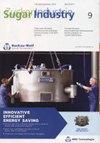Row-spacing and cultivar effects on sugarcane growth and yields in Florida histosols
IF 0.2
4区 农林科学
Q4 FOOD SCIENCE & TECHNOLOGY
引用次数: 0
Abstract
Sugarcane (Saccharum spp. hybrids) is a major row crop in Florida. The effect of row-spacing on total row length per hectare can significantly effect the cost of major farm operations, including planting, harvesting and fertilizer application. In Florida, sugarcane is commonly planted at 1.5 m row-spacing. There is little information available on the effect of relatively narrow or wide spacing on the growth and yield of sugarcane, especially in new high-biomass cultivars. To determine sugarcane growth response to different row-spacing, a field trial was conducted in organic soil (Histosols) with four different row-spacings (1.2, 1.5, 1.8 m and a double row on a 1.5 m bed) and three sugarcane cultivars (CP 96-1252, CP 00-1101 and CP 01-1372). Data showed differential row-spacing effects on plant cane versus the first ratoon. In plant cane, depending on the cultivar, double row and 1.2 m spacing produced 17–46% and 23–42% greater sugar yield per hectare (TSH) than the current 1.5 m spacing, respectively. Overall, the combined average TSH of plant cane and the first ratoon in double and 1.2 m spacing was 20% and 26% greater than 1.5 m spacing. However, the yields in 1.5 m and 1.8 m row-spacing were similar. There was no significant effect in the first ratoon. There was no row-spacing effect on sucrose concentration. A similar response of cultivars to the tested row-spacings suggests that selecting cultivars for different row-spacings may not potentially show any yield improvements. Compared to the current 1.5 m spacing, narrow-spacing (1.2 m and double row) may potentially increase yields and wide (1.8 m) spacing reduce the production cost but further research is needed to understand the economic feasibility of different row configurations.行距和品种对佛罗里达州甘蔗生长和产量的影响
甘蔗(Saccharum spp.杂交种)是佛罗里达州主要的行作物。行距对每公顷总行长的影响可以显著影响主要农场经营的成本,包括种植、收获和施肥。在佛罗里达州,甘蔗通常以1.5 米的行距种植。关于较窄或较宽间距对甘蔗生长和产量的影响,特别是对高生物量新品种的影响,目前的资料很少。为了确定甘蔗生长对不同行距的响应,在4种不同行距(1.2、1.5、1.8 m和1.5 m床上的双行)的有机土壤(Histosols)和3个甘蔗品种(CP 96-1252、CP 00-1101和CP 01-1372)上进行了田间试验。数据显示不同行距对植株甘蔗与第一代的影响。在甘蔗中,根据不同的品种,双行和1.2 m间距比目前的1.5 m间距分别提高17-46%和23-42%的每公顷糖产量。总体而言,两倍和1.2 m行距下,植株和第一叶的TSH分别比1.5 m行距高20%和26%。行距1.5 m和1.8 m的产量相近。在第一个周期没有明显的效果。行距对蔗糖浓度没有影响。品种对所测行距的类似反应表明,选择不同行距的品种可能没有潜在的产量提高。与目前的1.5 m间距相比,窄间距(1.2 m和双行)可能会提高产量,宽间距(1.8 m)可以降低生产成本,但需要进一步研究以了解不同行配置的经济可行性。
本文章由计算机程序翻译,如有差异,请以英文原文为准。
求助全文
约1分钟内获得全文
求助全文
来源期刊

Sugar Industry-Zuckerindustrie
工程技术-食品科技
CiteScore
0.50
自引率
50.00%
发文量
22
审稿时长
18-36 weeks
期刊介绍:
Sugar Industry / Zuckerindustrie accepts original papers (research reports), review articles, and short communications on all the aspects implied by the journals title and subtitle.
 求助内容:
求助内容: 应助结果提醒方式:
应助结果提醒方式:


